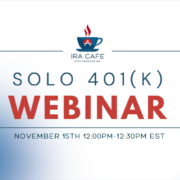What You Didn’t Know about the Self-Directed Solo 401(k)
Talk about the 401(k) around the water cooler and most people think they know what you mean. It’s an employer-sponsored retirement plan, and maybe not everyone understands it, but they understand how to take money out of their paycheck every month and redirect it towards retirement. And it’s a method that can work for many people. But what many people don’t know is that there’s a more independent version of the 401(k) available to them: the Self-Directed Solo 401(k) plan.
But what is a Solo 401(k) plan, and how does it differ from what people are used to? Here are a few facts that you might not have known.
- The Solo 401(k) is just a different type of 401(k). Even though it has a different name—the IRS often calls them one-participant plans to denote its solo status—the Solo 401(k) still uses the same number of the tax code, which means many of the same rules apply. That means the same basic structure is in place, you’re just using two “buckets” to fund the account. As a business owner that qualifies for a Solo 401(k), you contribute to the account both as the employee (personal contributions) and as the employer (like a traditional 401(k)).
- You can buy alternative assets in a 401(k) plan. Using a Self-Directed Solo 401(k) plan means you have the option of investing in alternative asset classes. This might sound more unorthodox than it really is. It simply means that you can choose from a wider range of legitimate retirement investments, such as real estate, precious metals, private stock, and even Single Member LLCs. In fact, there’s a way to have “Checkbook Control” when you use a Single Member LLC. The net result of this arrangement is that you can be very flexible in the way you approach investing, using the freedom and control of having a checkbook within a retirement account. However, it’s worth noting this isn’t a free pass to invest in anything you want; the same retirement rules apply.
- There are catch-up contributions available with a Solo 401(k). One of the nicest features of a Solo 401(k) is that if you have a little more money to spare and you’re reaching retirement age, you can zoom ahead with some additional catch-up contributions. In 2021, for example, the annual contribution limits go up an additional $6,500 if you’re over the age of 50 and meet all of the other requirements of using a Self-Directed Solo 401(k).
- You can borrow from a Self-Directed Solo 401(k). You can borrow up to $50,000 or 50% of your account value, whichever is lower, for any purpose. The catch is that all loans must be paid back within 5 years. However, this is a great way for some people to realize that investing in a Self-Directed retirement account does not mean having to wave goodbye to your money for an extended period of time; there are often circumstances which give you some more flexibility throughout your life.
Expanding to a Self-Directed Solo 401(k) plan doesn’t have to be the complicated system that many investors think it is. It simply means that you’re taking more of your retirement into your own hands. By working with a reputable Self-Directed IRA administration firm, you can have assistance in setting up the account properly.
Interested in learning more about Self-Directed IRAs? Contact American IRA, LLC at 866-7500-IRA (472) for a free consultation. Download our free guides or visit us online at www.AmericanIRA.com.









